Garden Tips Make Garden Planter: Easy Steps for a Beautiful Garden
Gardening can be a rewarding and fun activity, making it easy for you to relax and enjoy the outdoors. One great way to enhance your garden space is by using planters, which can be both decorative and functional. Using planters allows you to add a variety of plants in different areas, bringing life and color to your garden.

You’ll find that creating your own garden planters can be a simple and enjoyable project. Whether you are a beginner or an experienced gardener, there are plenty of ideas and tips to help you design beautiful and effective planters for your space. By following a few basic guidelines, you can successfully grow a wide range of plants in containers.
1) Use raised beds

Raised beds are a fantastic option for your garden. They help improve drainage and keep your soil warm, which is perfect for growing a variety of plants.
You can space plants closer together since you don’t need to leave room for walking, making the most of your space. Try planting lettuce by poking holes at 6-inch intervals and planting seeds.
Raised beds also make it easy to control weeds. Start by placing a layer of cardboard at the bottom to discourage weeds and invite helpful earthworms.
2) Choose Native Plants

Native plants are a great choice for your garden. They are adapted to the local climate and soil, which makes them easier to care for. Plus, they support local wildlife like bees and butterflies.
When selecting plants, think about the sunlight and water needs of each. Group plants with similar needs together. This helps them thrive and makes your maintenance tasks easier.
Avoid invasive species. These can harm local ecosystems. You can learn more about this from Epic Gardening. Taking these steps will make your garden both beautiful and sustainable.
3) Mulch Your Garden

Mulching your garden is a great way to keep your plants healthy. Organic mulches like hardwood or cocoa bean hulls are ideal. Aim for about three to four inches around the plants but avoid touching the stems.
Mulch helps retain moisture and suppress weeds. You can use wood chips or wood bark, though they decompose slowly and can get messy in wind or rain.
Mulching in early to mid-spring, and again in the fall, is perfect for maintaining a fresh look and healthy soil. This also prevents weeds from popping up as the weather warms.
Consider using environmentally friendly options like cypress or cedar wood chips, which not only enrich the soil but are sustainable too.
4) Install a drip irrigation system

A drip irrigation system helps make watering your garden easy. It saves time and water. You can set it up yourself with a few simple steps.
First, lay out your mainline tubing around your garden. This will carry water to the plants. Make sure it reaches all the areas you want to water.
Next, punch holes in the mainline tubing where you want to add drip lines. Use a drip irrigation hole punch for this. Then, connect the drip lines to these holes.
Lastly, attach dripper heads to the open ends of the drip lines. Place a dripper head in each plant container, near the plant roots. This ensures water goes straight to your plants.
Setting up a drip irrigation system can make your gardening life much simpler. It’s a great way to keep your plants happy and well-watered. For more detailed instructions, you can check this guide.
5) Plant companion plants

Planting companion plants is a great way to boost your garden’s health. Some plants work well together by helping each other grow better.
For example, tomatoes and basil make a perfect pair. Basil helps repel pests that like to munch on tomatoes. Beans and corn are also great companions, with corn providing a natural trellis for the beans to climb.
Certain plants, like lettuce, grow well in the shade provided by taller plants, such as corn. This can help them thrive even in the hot summer sun.
Experiment with different combinations to find what works best for your garden!
6) Rotate your crops

Rotating your crops helps keep your garden healthy and productive.
By not planting the same crops in the same place every year, you can avoid the buildup of pests and diseases. Pests and diseases that affect specific plants won’t have a continuous host.
Moving crops also helps manage soil nutrients. Different plants have different nutrient needs. Switching them around ensures your soil stays fertile and balanced. For example, after growing heavy feeders like tomatoes, plant legumes to help replenish nitrogen.
You can learn more about crop rotation at The Old Farmer’s Almanac.
7) Compost kitchen scraps

Composting kitchen scraps is a great way to reduce waste and enrich your garden soil. Start by collecting vegetable peels, fruit cores, coffee grounds, and eggshells. These scraps will break down and become nutrient-rich compost.
To compost effectively, mix your scraps with yard waste like grass clippings and dead leaves. This helps balance the compost and speed up decomposition.
If you’re using a compost bin, turn the pile regularly to keep it aerated. This ensures that the compost breaks down evenly. For container gardens, add about one-third compost to two-thirds potting soil to boost your plants.
8) Use Organic Fertilizers

Using organic fertilizers can benefit your garden in many ways. These fertilizers are made from natural materials, like composted manure or bone meal.
Organic fertilizers can improve soil structure, helping soil hold water better and ensuring good aeration. This can lead to healthier plant roots.
These fertilizers release nutrients slowly, which means your plants get a steady supply over time. This reduces the chances of nutrient loss and salt injury to your plants.
For more information on how to use organic fertilizers, you can visit Country Living.
9) Prune Regularly

Pruning is crucial for keeping your garden looking its best. By trimming back excess branches and leaves, you help your plants focus energy on producing fruits and flowers.
Use clean, sharp pruners to avoid spreading disease. Always remove dead or damaged branches first. This helps the plant stay healthy and grow better.
For more details on pruning techniques, check out this guide for beginners. Regular pruning will keep your garden vibrant and under control.
10) Install a rain barrel

Setting up a rain barrel in your garden is a smart way to collect free water for your plants.
Start by choosing a sturdy barrel. Clean it thoroughly to ensure it’s free from any contaminants.
Detach the downspout from your gutter and connect it to the barrel using a flex-elbow connector. This step helps channel rainwater directly into the barrel.
For more detailed steps, you can check out how to install a rain barrel.
Benefits of Growing Your Own Garden Plants

Growing your own garden plants offers numerous benefits, from boosting your health with fresh produce to helping the environment by reducing waste and pollution.
Health Benefits of Homegrown Produce
Homegrown produce is often more nutritious than store-bought options. Vegetables and fruits picked right from your garden retain more vitamins and minerals since they don’t have to travel long distances or sit on store shelves. Fresh produce can enhance your diet with essential nutrients and flavors that supermarket produce often lacks.
Gardening is also a form of exercise. While planting, weeding, and harvesting, you engage in activities that can improve your physical fitness. These activities can help reduce stress levels and improve mental health by providing a sense of accomplishment and connection to nature.
Moreover, growing your own food means you control what goes into your soil and plants. You have the advantage of avoiding harmful pesticides and chemicals, ensuring that your produce is organic and safe to eat. This makes your meals healthier and more sustainable.
Environmental Advantages
Gardening at home can have a positive impact on the environment. When you grow your own plants, you reduce the need for store-bought produce, which often comes with a large carbon footprint due to transportation and packaging. This minimizes greenhouse gas emissions and helps combat climate change.
Your garden also contributes to a healthier ecosystem. By planting a variety of plants, you encourage biodiversity, which is vital for maintaining balanced and resilient local wildlife populations. Plants in your garden can provide food and shelter for bees, birds, and other beneficial insects.
Additionally, growing your own plants reduces waste. You can compost your organic waste to enrich the soil, creating a closed-loop system that minimizes landfill contributions. By avoiding single-use plastics and packaging from store-bought produce, you further decrease environmental pollution.
Choosing the Right Planter for Your Garden

Finding the right planter can enhance your garden’s look and the health of your plants. Consider the type and material of the planter to ensure they suit your garden needs.
Types of Garden Planters
Garden planters come in various forms. Hanging planters are great for small spaces or adding vertical interest. Raised bed planters provide excellent drainage and make gardening accessible. Container planters are versatile and can be easily moved to catch sunlight or redecorate.
For a unique touch, you can choose window boxes. They add charm to windowsills and can hold flowers or small herbs. Large decorative planters can become focal points in your garden, housing bigger plants or small trees.
Materials and Their Pros and Cons
Clay Planters are classic and offer good breathability for plant roots. However, they can be heavy and breakable. Wooden Planters provide a natural look and good insulation but require maintenance to prevent rot. You might need to treat them with a sealant occasionally.
Plastic Planters are lightweight and come in many styles. They are less expensive but may not last as long outdoors. Metal Planters create a modern look and are very durable, though they can heat up in the sun and potentially harm plant roots.
Concrete Planters are sturdy and can handle large plants, but they are heavy and hard to move. Composite Planters mix materials like fiberglass and cement, combining durability and lightness. They are weather-resistant and come in various designs.
How to Maintain Your Garden Planters

To keep your garden planters thriving, you’ll need to manage a proper watering schedule and provide the right soil care and fertilization. These practices will ensure your plants stay healthy and productive.
Watering Schedule and Techniques
Watering your garden planters correctly is crucial. Aim to water in the early morning or late afternoon. This helps reduce water evaporation and keeps the plants hydrated throughout the day.
For optimal results, use a soaker hose or drip irrigation system. These methods provide consistent moisture without overwatering. Make sure water reaches the root zone, not just the surface.
Check the soil moisture regularly by sticking your finger about an inch deep into the soil. If it feels dry, it’s time to water. During hot weather, you may need to water more frequently, but always avoid making the soil soggy.
Soil Care and Fertilization Tips
Healthy soil leads to healthy plants. Start by using a high-quality potting mix with good drainage properties. Mix in organic matter like compost to improve soil structure and enrich it with nutrients.
Fertilization is key for planter success. Use a balanced, slow-release fertilizer or a diluted liquid fertilizer. Follow package instructions to avoid over-fertilization, which can harm plants.
Regularly check for and remove debris such as fallen leaves or dead flowers. This helps prevent disease and pest problems. If you notice any yellowing leaves or stunted growth, it might be a sign to adjust your fertilization routine or check for pests.







